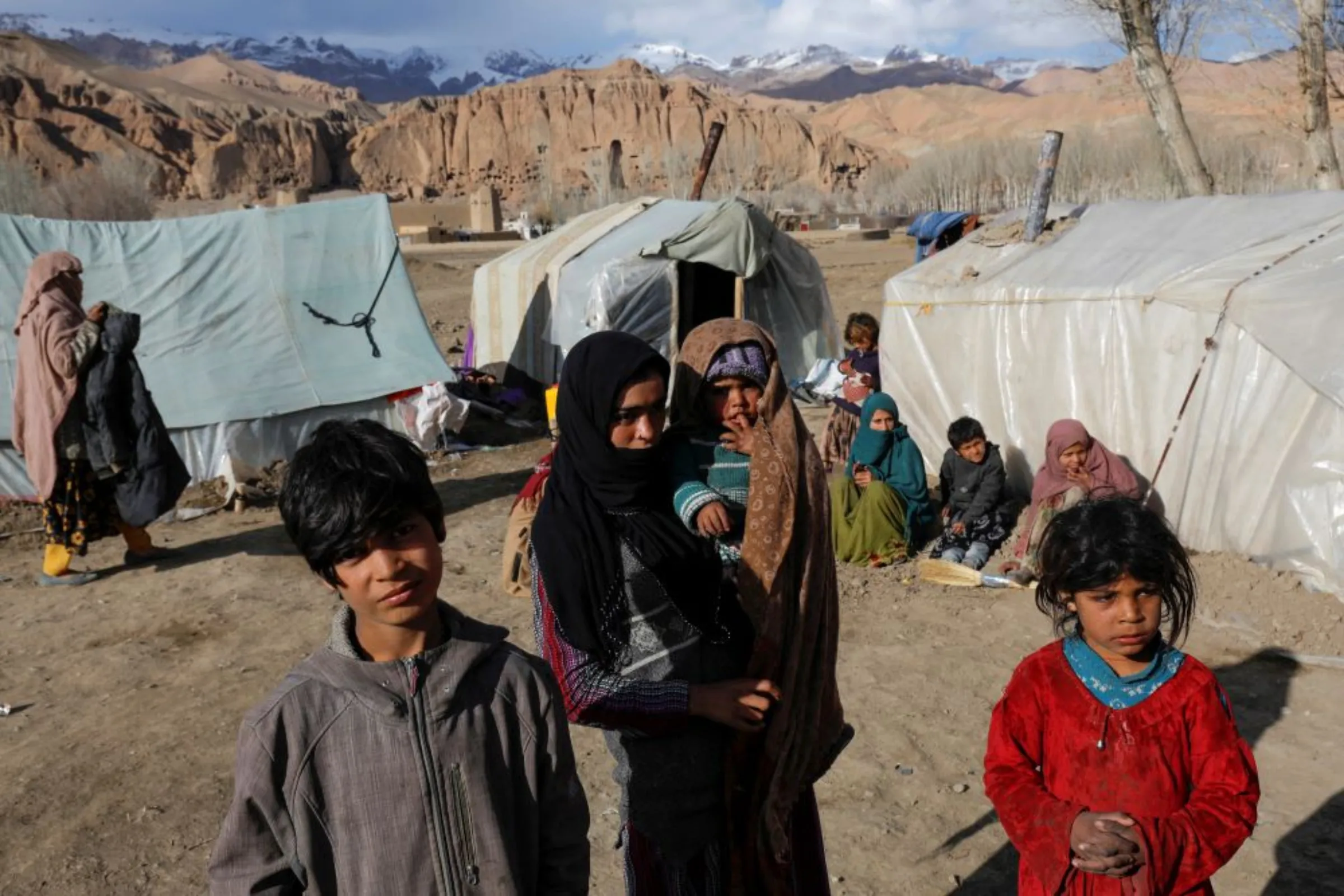Context is powered by the Thomson Reuters Foundation Newsroom.
Our Standards: Thomson Reuters Trust Principles

A displaced Afghan family from Kunduz province, whose house was destroyed by flood, lives in an open area in front of the ruins of a 1500-year-old Buddha statue, in Bamiyan, Afghanistan, March 2, 2023. REUTERS/Ali Khara
Britain is facing criticism for cutting its foreign aid budget, putting thousands of lives at risk around the world
LONDON - Britain will keep its foreign aid spending at 0.5% of economic output until its fiscal situation improves, according to a government White Paper on international development.
Britain's Conservative government reduced overseas aid from 0.7% to 0.5% of gross national income (GNI) in 2020 to free up cash for domestic spending during COVID-19, slashing billions from programmes supporting the world's poorest.
In its White Paper, published this week, the government said it was committed to restoring the 0.7% target "once the fiscal situation allows", and outlined Britain's 2030 roadmap to tackle climate change and poverty.
However, some charities said the policy document did not go far enough and questioned where the money would come from for the various policy commitments.
"There is a nagging question of how they will be resourced when the UK aid budget remains at 0.5% of national income, with a third of this currently being used to support refugees in the UK," said Gideon Rabinowitz, director of policy and advocacy at Bond, an umbrella group of UK aid groups.
In Wednesday's Autumn Statement budget, finance minister Jeremy Hunt said Britain's economy will grow much more slowly than previously thought over the next few years.
With former prime minister David Cameron now back in government as foreign secretary, charities say they are hopeful the UK will be more ambitious on reducing extreme poverty, and have urged Cameron to reinstate the 0.7% aid target which he enshrined into law in 2015.
Here are the details of Britain's foreign aid spending:
In 1970, Britain pledged to spend at least 0.7% of GNI on foreign aid as part of a United Nations pact.
It is among 30 wealthy countries including the United States, Germany and Japan that have vowed to meet this minimum commitment each year.
Britain spent $15.7 billion in aid in 2022 - including domestic spending such as refugee programmes - slightly down from $15.8 billion in 2021, according to preliminary data from the Organisation for Economic Co-operation and Development (OECD).
In its Autumn Statement on November 22, the government said it had committed 30 million pounds ($37.38 million) in additional humanitarian aid to the Palestinian Territories since Oct. 7.
The top five countries to receive UK aid money in 2022 were Afghanistan, Ukraine, Nigeria, Somalia and Ethiopia, with almost all funds going to countries in Africa and Asia, according to government data.
Several countries have exceeded the U.N. aid target including Germany (0.83%), Luxembourg (1.00%), Norway (0.86%) and Sweden (0.90%), according to the OECD data.
The United States was the biggest cash donor in 2022. It spent $55.3 billion, followed by Germany ($35 billion), Japan ($17.5 billion), France ($15.9 billion) and Britain.
Britain's aid cuts impacted almost all international programmes dealing with global health and humanitarian work, charities say.
Sexual health programmes across Africa would face a 60% cut in funding, according to an assessment by the International Development Committee (IDC) of lawmakers in August.
About 230,000 children will miss out on education after funding was reduced by 87%, the assessment said, and more than 25,000 children suffering from severe malnutrition in South Sudan would not get treatment.
Other programmes impacted by sharp cuts included initiatives to deter female genital mutilation (FGM) in Somalia, support women and girls under Taliban rule in Afghanistan, and to vaccinate children.

Migrants walk at a makeshift migrant camp in Dunkerque near Calais, France, January 13, 2022. REUTERS/Yves Herman
Migrants walk at a makeshift migrant camp in Dunkerque near Calais, France, January 13, 2022. REUTERS/Yves Herman
In its White Paper, the government said a key priority was to meet the U.N.'s Sustainable Development Goals (SDGs), global targets set in 2015 to fight issues such as hunger, poverty and climate change by 2030.
Yet at the halfway mark to the deadline, only 15% of the targets are on track, according to the U.N.
The government said it would ensure aid money is used to reduce poverty and it aimed to spend at least 50% of all its bilateral aid in developing nations, which are often vulnerable to conflicts and climate change.
Aid groups had expressed concern after data showed that more than 40% of Britain's development aid budget in 2022 was spent by departments outside the foreign and development ministry.
About 3.7 billion pounds ($4.6 billion) in aid - nearly a third of the entire budget - that should have been used to help vulnerable people overseas was instead spent on hosting refugees in Britain, most of them Ukrainian, official data showed.
At a food security summit this week, Britain said up to 100 million pounds of aid money would be spent this financial year to tackle hunger and malnutrition in places like Ethiopia, Sudan, South Sudan, the Sahel and Afghanistan.
An additional 100 million pounds from the aid pot would be spent over the next five years to build climate resilience in Somalia to prevent future humanitarian crises.
New to Context? We'd love for you to find out a little more about what we do. Click here for a selection of our best work.
This article was updated on November 22, 2023 to include details of the Autumn Statement and White Paper on International Development.
(Reporting by Lin Taylor; Editing by Helen Popper and Sonia Elks and Lyndsay Griffiths)
Context is powered by the Thomson Reuters Foundation Newsroom.
Our Standards: Thomson Reuters Trust Principles